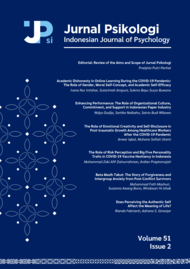The Indonesian Version of the Depressive Symptom Index-Suicidality Subscale: Adaptation and Psychometric Evaluation
Lavenda Geshica(1*), Ferdi W Djajadisastra(2), Sugiarti Sugiarti(3)
(1) Faculty of Psychology, University of Gadjah Mada
(2) Australian National University
(3) Faculty of Psychology, Universitas Indonesia
(*) Corresponding Author
Abstract
Keywords
Full Text:
PDFReferences
Batterham, P. J., Ftanou, M., Pirkis, J., Brewer, J. L., Mackinnon, A. J., Beautrais, A., Kate Fairweather-Schmidt, A., & Christensen, H. (2015). A systematic review and evaluation of measures for suicidal ideation and behaviors in population-based research. Psychological Assessment, 27(2), 501–512. https://doi.org/10.1037/pas0000053
Beaton, D. E., Bombardier, C., Guillemin, F., & Ferraz, M. B. (2000). Guidelines for the Process of Cross-Cultural Adaptation of Self-Report Measures. In SPINE (Vol.25, Issue 24).
Blanchard, M., & Farber, B. A. (2020). “It is never okay to talk about suicide”: Patients’ reasons for concealing suicidal ideation in psychotherapy. Psychotherapy Research, 30(1), 124–136. https://doi.org/10.1080/10503307.2018.1543977
Boudreaux, E. D., & Horowitz, L. M. (2014). Suicide Risk Screening and Assessment: Designing Instruments with Dissemination in Mind. American Journal of Preventive Medicine, 47(3, Supplement 2), S163–S169. https://doi.org/https://doi.org/10.1016/j.amepre.2014.06.005
Dozois, D. J. A., & Covin, R. (2004). The Beck Depression Inventory-II (BDI-II), Beck Hopelessness Scale (BHS), and Beck Scale for Suicide Ideation (BSS). In Comprehensive handbook of psychological assessment, Vol. 2: Personality assessment.
(pp. 50–69). John Wiley & Sons, Inc.
Dube, P., Kroenke, K., Bair, M. J., Theobald, D., & Williams, L. S. (2010). The P4 screener: Evaluation of a brief measure for assessing potential suicide risk in 2 randomized effectiveness trials of primary care and oncology patients. Primary
Care Companion to the Journal of Clinical Psychiatry, 12(6). https://doi.org/10.4088/PCC.10m00978blu
Firestone, R. (1998). Voices in Suicide: The Relationship Between Self-Destructive Thought Process, Maladaptive Behavior, and Self-Destructive Manifestations. Death Studies, 22(5), 411–443. https://doi.org/10.1080/074811898201443
Joiner, T. E., Pfaff, J. J., & Acres, J. G. (2002). A brief screening tool for suicidal symptoms in adolescents and young adults in general health settings: reliability and validity data from the Australian National General Practice Youth Suicide Prevention Project. Behaviour Research and Therapy, 40(4), 471–481. https://doi.org/https://doi.org/10.1016/S0005-7967(01)00017-1
Kline, P. (1986). Making tests reliable II: Personality inventories." A handbook of test construction: Introduction to psychometric design. Methuen. Kroenke, K., Spitzer, R. L., & Williams, J. B. W. (2003). The Patient Health
Questionnaire-2: Validity of a Two-Item Depression Screener. Medical Care, 41(11), 1284–1292. http://www.jstor.org/stable/3768417
Logan, B., & Burns, S. (2021). Stressors among young Australian university students: A qualitative study. Journal of American College Health, 1–8.https://doi.org/10.1080/07448481.2021.1947303
May, A. M., & Klonsky, E. D. (2016). What distinguishes suicide attempters from suicide ideators? A meta‐analysis of potential factors. Clinical Psychology: Science and Practice, 23, 5–20. https://doi.org/10.1037/h0101735
Merritt, M., Fisher, L., Goldney, R. D., & Watson, D. (2001). The measurement of suicidal ideation. Crisis, 22(1), 12–14. http://dx.doi.org/
Metalsky, G. I., & Joiner, T. E. (1997). The Hopelessness Depression Symptom Questionnaire. Cognitive Therapy and Research, 21(3), 359–384. https://doi.org/10.1023/A:1021882717784
Millner, A. J., Lee, M. D., & Nock, M. K. (2015). Single-Item Measurement of Suicidal Behaviors: Validity and Consequences of Misclassification. PLOS ONE, 10(10), e0141606. https://doi.org/10.1371/journal.pone.0141606
Ministry of Health of the Republic of Indonesia. (2019). Situasi dan Pencegahan Bunuh Diri .
Nunnally, J. C. (1978). Psychometric Theory 2nd ed. Mcgraw hill book company.
O’Neill, S., McLafferty, M., Ennis, E., Lapsley, C., Bjourson, T., Armour, C., Murphy, S.,
Bunting, B., & Murray, E. (2018). Socio-demographic, mental health and childhood adversity risk factors for self-harm and suicidal behaviour in College students in Northern Ireland. Journal of Affective Disorders, 239, 58–65.https://doi.org/https://doi.org/10.1016/j.jad.2018.06.006
Prawira, B., Magdalena, S., Jenifer, M., Rachmadianti, S., Hanifa, S., Liem, A., Perilaku, L., Layanan, P., & Mental, K. (2021). Seri Laporan ke-1: Laporan Perilaku Penggunaan Layanan Kesehatan Mental di Indonesia 2021 – Hasil Awal. www.intothelightid.org.
Richardson, T., Elliott, P., Roberts, R., & Jansen, M. (2017). A Longitudinal Study of Financial Difficulties and Mental Health in a National Sample of British Undergraduate Students. Community Mental Health Journal, 53(3), 344–352. https://doi.org/10.1007/s10597-016-0052-0
Sadeghi Bahmani, D., Faraji, P., Faraji, R., Lang, U. E., Holsboer-Trachsler, E., & Brand, S. (2018). Is emotional functioning related to academic achievement among university students? Results from a cross-sectional Iranian sample. Revista Brasileira de Psiquiatria, 40(3), 290–295. https://doi.org/10.1590/1516-4446-2017-2434
Sommers-Flanagan, J., & Shaw, S. L. (2017). Suicide risk assessment: What psychologists should know. Professional Psychology: Research and Practice, 48, 98–106. https://doi.org/10.1037/pro0000106
Spitzer, R. L., Williams, J. B. W., Kroenke, K., Linzer, M., deGruy III, F. V., Hahn, S. R., Brody, D., & Johnson, J. G. (1994). Utility of a New Procedure for Diagnosing Mental Disorders in Primary Care: The PRIME-MD 1000 Study. JAMA, 272(22), 1749–1756. https://doi.org/10.1001/jama.1994.03520220043029
Stevens, P. J. (2009). Applied multivariate statistics for the social sciences (5th ed.). Routledge.
Van Orden, K. A., Witte, T. K., Cukrowicz, K. C., Braithwaite, S. R., Selby, E. A., & Joiner, T. E. (2010). The Interpersonal Theory of Suicide. Psychological Review, 117(2), 575–600. https://doi.org/10.1037/a0018697
World Health Organization. (2021). Suicide worldwide in 2019: global health estimates.
Article Metrics
Refbacks
- There are currently no refbacks.
Copyright (c) 2023 Jurnal Psikologi

This work is licensed under a Creative Commons Attribution-ShareAlike 4.0 International License.
Recent Issues
 |  |  |  | ||||
| Vol 51 Issue 2 (2024) Page 120-230 | Vol 51 Issue 1 (2024) Page 1-119 | Vol 50 Issue 3 (2023) Page 219-332 | Vol 50 Issue 2 (2023) Page 125-218 |
| Published by Faculty of Psychology, Universitas Gadjah Mada, Indonesia Building D-6th, Floor No. D-606. Jl. Sosio Humaniora No. 1, Bulaksumur Yogyakarta, 55281 Email: jurnalpsikologi@ugm.ac.id Phone/whatsApp: +6281125210175 |











